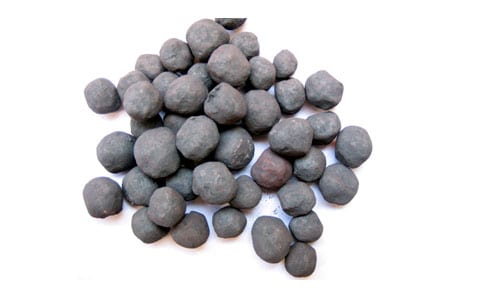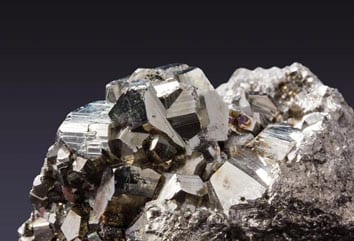Yan Language:
Irin irin ni kẹrin wọpọ ano ni ilẹ ayé ká erunrun. Iron ni awọn ibaraẹnisọrọ to, irin ẹrọ ki o si nitorina ẹya awọn ibaraẹnisọrọ ohun elo ti fun agbaye aje idagbasoke. Iron ti wa ni tun gbajumo ni lilo ni ikole ati awọn ẹrọ ti awọn ọkọ. Julọ ti irin irin oro ti wa ni kq ti metamorphosed fi ọjá irin formations (BIF) ninu eyi ti iron ti wa ni commonly ri ni awọn fọọmu ti oxides, hydroxides ati ki o si a kere iye carbonates.
Awọn kemikali tiwqn ti irin ores ni o ni ohun kedere jakejado ibiti o ni kemikali tiwqn paapa fun Fe akoonu ati nkan gangue ohun alumọni. Major iron ohun alumọni ni nkan ṣe pẹlu julọ ninu awọn irin ores wa ni hematite, goethite, limonite ati magnetite. Awọn ifilelẹ ti awọn contaminants ni iron ores ni o wa SiO2 ati Al2O3. Awọn aṣoju yanrin ati alumina ti nso ohun alumọni bayi ni iron ores ni o wa kuotisi, kaolinite, gibbsite, diaspore ati corundum. Of these it is often observed that quartz is the main silica bearing mineral and kaolinite and gibbsite are the two-main alumina bearing minerals.


Irin irin isediwon wa ni o kun ošišẹ ti nipasẹ ìmọ ọfin iwakusa mosi, Abajade ni significant tailings iran. Awọn irin irin gbóògì eto maa je meta ni asiko: iwakusa, processing ati pelletizing akitiyan. ti awọn wọnyi, processing idaniloju wipe ohun deedee irin ite ati kemistri ti waye saju si pelletizing ipele. Processing pẹlu crushing, classification, milling, and concentration aiming at increasing the iron content while reducing the amount of gangue minerals. Kọọkan ni erupe ile idogo ni o ni awọn oniwe-ara oto abuda pẹlu ọwọ lati irin, ati gangue ti nso ohun alumọni, ati nitorina o nilo kan ti o yatọ fojusi ilana.
Magnetic separation is typically used in high-grade iron ore beneficiation where the dominant iron minerals are ferro and paramagnetic. Tutu ati ki o gbẹ kekere-kikankikan se Iyapa (LIMS) imuposi ti wa ni lo lati ilana ores pẹlu lagbara se ini bi magnetite nigba ti tutu ga-kikankikan se Iyapa ti lo lati pàla awọn Fe-ti nso ohun alumọni pẹlu lagbara se ini gẹgẹ bi awọn hematite lati gangue ohun alumọni. Iron ores iru goethite ati limonite ti wa ni commonly ri ni tailings ati ki o ko ya gidigidi daradara nipa boya ilana.

Flotation ti lo lati din awọn akoonu ti impurities ni kekere-ite iron ores. Iron ores le ti wa ni ogidi boya nipa taara anionic flotation ti irin oxides tabi ẹnjinia cationic flotation ti yanrin, sibẹsibẹ ẹnjinia cationic flotation si maa wa ni julọ gbajumo flotation ipa lo ninu awọn iron ile ise. Awọn lilo ti flotation awọn oniwe-ni opin nipa awọn iye owo ti reagents, niwaju ti yanrin ati alumina-ọlọrọ slimes ati niwaju kaboneti ohun alumọni. Jubẹlọ, flotation nilo egbin omi itoju ati awọn lilo ti ibosile dewatering fun gbẹ ase ohun elo.
Awọn lilo ti flotation fun awọn fojusi ti iron tun je desliming bi lilefoofo ni niwaju itanran esi ni din ku ṣiṣe ati ki o ga reagent owo. Desliming jẹ paapa lominu ni fun awọn yiyọ ti alumina bi awọn Iyapa ti gibbsite lati hematite tabi goethite nipa eyikeyi dada-lọwọ òjíṣẹ jẹ ohun soro. Julọ ti alumina ara alumọni ba waye ninu awọn finer iwọn ibiti o (<20um) allowing for its removal through desliming. ìwò, a high concentration of fines (<20um) and alumina increases the required cationic collector dose and decreases selectivity dramatically. Therefore desliming increases flotation efficiency, but results in a large volume of tailings and in loss of iron to the tailings stream.
Dry processing of iron ore presents an opportunity to eliminate costs and wet tailings generation associated with flotation and wet magnetic separation circuits. STET has evaluated several iron ore tailings and run of mine ore samples at bench scale (pre-feasibility scale). Significant movement of iron and silicates was observed, with examples highlighted in the table below.

Awọn esi ti iwadi yi afihan wipe-kekere ite irin irin itanran le wa ni igbegasoke nipasẹ ọna ti STET tribo-electrostatic igbanu separator. Based on STET experience, awọn ọja imularada ati / tabi awọn ite yoo significantly mu ni asewo asekale processing, bi akawe si ibujoko-asekale igbeyewo ẹrọ nlo nigba wọnyi irin irin idanwo.
The STET dry electrostatic fine iron ore separation process offers many advantages over traditional wet processing methods, such as magnetics or flotation, pẹlu:
Contact us to learn more about dry processing of iron ore.
to jo: